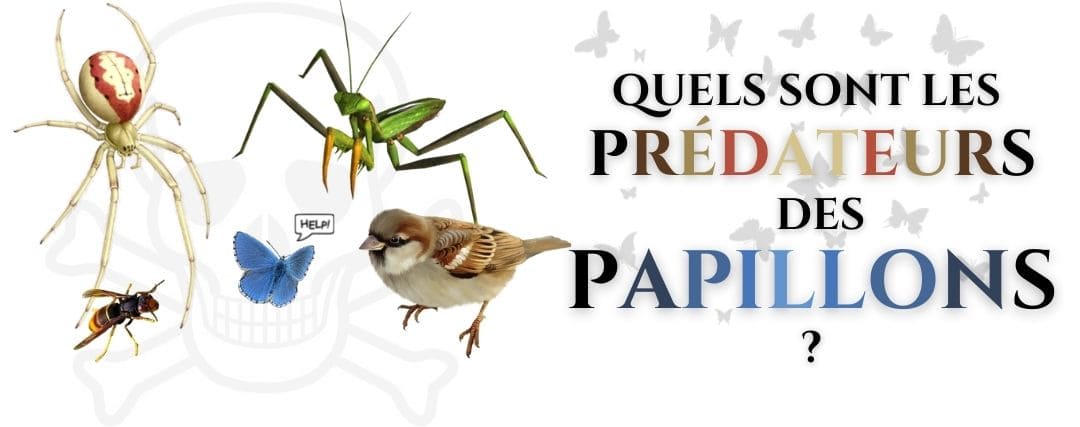Controlling Butterfly Populations in Nature
Strictly speaking, predators and parasitoids should not be considered enemies of butterflies. Instead, they might be seen as nature's way of keeping butterfly populations from becoming unmanageable.
If left unchecked, populations can quickly rise and deplete all available food resources, ultimately leading to their own extinction.
A butterfly can lay up to 500 eggs, but on average, it lays around a hundred because many females die before laying all their eggs. About 95% of these eggs will hatch, and 85% of the resulting caterpillars will likely be killed by birds, wasps, spiders, or parasitoids, leaving only 10% to reach pupation. Studies show that more than half of wild nymphs are eaten, killed by parasitoids, or die from desiccation, fungal attack, or other causes.
Ultimately, the eggs laid by a single butterfly will, on average, produce about 4 adults per generation. Up to half of adult butterflies will be killed before they mate or lay eggs. So, despite the capacity to produce 500 eggs, each clutch will only yield two butterflies. Ideally, one will be male and the other female, leading to another batch of eggs.

Avian Predators
Globally, adult butterflies are preyed upon by birds such as sparrows, tits, thrushes, robins, orioles, jays, grosbeaks, crossbills, flycatchers, jays, tanagers, and jacamars.
Various studies have provided statistical data on avian predation. For example, one study revealed that 160 of 697 specimens examined (23%) of Ascia monuste bore beak marks on their wings, indicating they had been attacked by birds but escaped. This does not include specimens that were actually eaten.
Another study on the feeding behavior of red-tailed jacamars in Costa Rica found that when 1679 butterflies from 133 species were offered to birds, about 5% were classified as failed attacks. 35% were ignored or dismissed, 20% were attacked and discarded after tasting, and 40% were attacked, killed, and eaten.
Butterflies are classified based on their color. Those rejected at sight or taste were usually aposematic species, while the less colorful or cryptically patterned butterflies were often devoured.
Studies show that at least 50% of wild butterflies are killed and eaten before they can mate and reproduce. They may be attacked when they emerge, dry their wings, bask on the ground, or visit flowers. Many escape with only a peck on the wing.
Birds and other vertebrate predators primarily use sight to locate their prey. Butterflies and moths have evolved visual defenses like camouflage, disguise, mimicry, warning coloration, and transparency to avoid attacks. When these passive defenses fail, active mechanisms come into play.

Spiders and Predatory Insects
Although birds are the top predators, adult butterflies also face threats from spiders, wasps, dragonflies, robber flies, and crickets.
In warm climates, they are also attacked by praying mantises and other arthropods. Butterflies often get caught by crab spiders lying in wait among flowers or in the webs of orb-weaving spiders.
Smaller butterflies like Polyommatus, Lysandra, and Coenonympha often get entangled and are quickly wrapped in silk for later consumption. Larger butterflies like Vanessa and Argynnis may escape before being attacked by the web's owner.
Adult butterflies often show a reticulation pattern on their wings where scales have broken off and stuck to the web. Wing scales may have evolved to be easily detachable as a survival mechanism.
In southern Britain, one common butterfly predator is the spider Enoplognatha ovata, which traps flying butterflies in its sticky web.
Males of the hunting spider Pisaura mirabilis attack butterflies on low grass, wrapping them in silk and offering them as gifts to female spiders. Crab spiders also prey on small butterflies, sometimes waiting motionless on a flower for days.
If a butterfly crosses a crab spider's field of vision, the spider seizes it with its powerful front legs and injects it with a paralyzing venom that liquefies the butterfly's tissues.

Hornets and wasps are major predators of butterflies in mid-to-late summer. In July 2009, in Alice Holt Forest, England, a Vespa crabro hornet was observed chasing butterflies. Although it failed to catch any, another hornet captured a butterfly, removed its wings, and carried it to its nest to feed its larvae. Adult hornets feed on nectar and fruit.
Caterpillar Predators
Butterfly and moth larvae are preyed upon by numerous predators. A study on Pieris rapae estimated that 52% and 63% of 1st and 2nd instar larvae were eaten by invertebrate predators like beetles, hemiptera, wasps, mites, and spiders. Up to 22% of older larvae were taken by birds feeding their young.
Birds, reptiles, amphibians, and small mammals rely on vision to find prey. Lepidoptera larvae have evolved visual defenses like camouflage, disguise, imitation, aposematic coloration, and stinging spines to repel attacks.
These strategies are effective against vertebrates but not invertebrates like spiders, wasps, and ants, which rely on smell. Some larvae, like Cerura vinula, use tail whips to strike attackers away.
Swallowtail larvae use cryptic colors and patterns as their first line of defense. If discovered, they inflate segments marked with "false eyes" to deter predators. They also turn over a structure called the osmeterium, which releases acids that repel ants and parasitoids.
Larvae of Lycaenidae form beneficial associations with ants, which protect them from predators and parasitoids. Some are carried to ant nests, where they feed on larvae, aphids, or fungi. Ants are deterred from attacking by chemicals or sounds produced by the larvae.
Research on Lycaenidae in Europe shows that their larvae and pupae generate sounds that prevent ant attacks.





